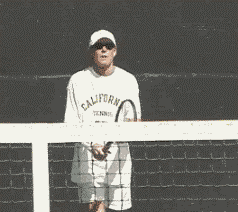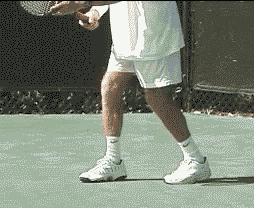
Return of Serve, page 2
by Scott Murphy

If you are seeing rockets, stand back for more time and see if the
server can take advantage of the angles or not.
|
Your Mind and Eyes
No matter where you
stand, your mindset and the use of your eyes are both critical in
preparing for the return.
A good returner will never allow himself to become a mental doormat for
the server. Your thinking should be “Bring it on!” not “Oh God, I hope I
get this back!”
You have to lean on that serve no matter how fast or slow it is. That is
not to say you take a maniacal swing at everything. It’s strictly your
mental approach.

Agassi’s early
focus sets his return apart.
|
Start watching the ball
during the server’s pre-serve routine. Be sure to check out the
Andre Agassi service return in our ProStrokes Gallery. What sets
him apart is how early he begins to focus when returning. Sometimes you
can literally see his eyes get bigger. A player that intent on seeing the
ball ALL the way can’t help but improve his timing.
Watch the Ball Bounce
This is huge! Two things will automatically happen when you do this.
You’ll watch the ball longer and you’ll know whether it was in or not if
it’s near the line.
You will also improve your timing, because research shows the ball
slows down dramatically at the bounce. That’s one reason we all tend to
get out in front of big serves. Seeing the bounce is critical because you
have fully one third of your time after the ball comes off the court at
this reduced speed. Sensing the speed change is critical to good timing.
(For more on this see:
Ball Speed and Your Return)
Planning the Return
Before the ball is
served you need to decide where you plan to hit it off either side. I say
“Plan” because sometimes with all the best intentions to do otherwise
you’ll be forced to go to a “Plan B.” For instance, the ball may be into
your body or way wide and now you need to do whatever it takes to get it
back.

The percentage directional on the return is always crosscourt.
|
In general, the directionals on your returns are just like the ones for groundstrokes. The
idea is to keep your court closed unless you have a good reason not to. (For more on this see
the Allen Fox article - Winning
Baseline Exchanges.)
Returning a serve down
the line can be very tempting but it can also open up the other side of
your court unless the server’s out of position, or has hit a weak serve
right into your wheelhouse. Even then going down the line you’re hitting
over the high part of the net, and to recover to the middle of the
server’s two widest angles, you have a lot more court to cover. Be sure
though to practice returning down the line because there’s definitely a
need for it and it could also mean hitting to a distinct weakness of the
server.
The crosscourt return
is the percentage return because you’re hitting over the low part of the
net to the deepest part of the court, and you have the least amount of
court to cover to be in position for the server’s next shot.
If the server stays
back make it a point to return with depth. If he’s a serve and volleyer
you’re going to want to mix up hitting the return at his feet, up the
line, low and crosscourt, and even putting up the occasional lob.

Be proactive with a step forward and a ready hop before your return.
|
Feet
So now you have decided
where you want to go with your return. Your eyes are focused on the
server, starting with his pre-serve rituals. Just before he strikes the
ball, take at least one step forward followed immediately by a split step
(ready hop).
Remember that you want
to be proactive and this gets you moving into the ball instead of being
flat-footed. The split steps sets your leg muscles to better move in
whatever direction is called for. I prefer to split step just before the
ball is hit because I feel it allows for more time to actually react to
the ball.
What your feet do after
the split step will vary depending on ball speed and placement. You may
hit in an open stance, a square stance, and even a closed stance if the
ball is far enough away. More on this when we get to the swings, so stay
tuned for Part 2!
|